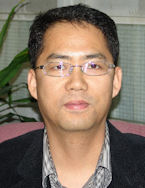|
"Optimal Design of Tandem and Nanostructured Organic/Inorganic Solar Cells"
Gon Namkoong, Ph.D.
Associate Professor of Electrical & Computer Engineering, Old Dominion University Tuesday, January 22, 2013, 2-3:15PM, Room 312, Rogers |
 |
|
Abstract:
Renewable energy sources are recognized as an important part of the current strategy to meet economic development, job creation, national security, and clean environment needs. In particular, the development of photovoltaic devices - a technology that directly converts daylight into electricity - continues to garner an ever-increasing scientific interest in industry as evidenced by a growth rate of approximately 25% per year. Even though inorganic solar cells are quitely promising as a renewable energy source, the need for easily produced, flexible, and reliable energy sources has spurred world-wide research efforts aimed at addressing the development of organic solar cells. However, organic solar cells fall far behind all the other solar cells in their efficiency. This is true even though their energy conversion efficiency has been continuously improved to more than 7% with the pioneering concept of multijunction (or tandem) solar cells and hybrid organic-inorganic systems. We present optical and electrical simulations to determine the optimal design for conjugated polymer-fullerene tandem solar cells. Currently there is no detailed prediction of achievable energy conversion efficiency and optimal design rules of such devices. In addition, a revolutionary device concept termed "nanostructured organic-inorganic solar cells" has been proposed to address the problems of sufficient charge extraction, collection efficiency, and the thickness dilemma. The hybrid nano-structured organic-inorganic solar cells are based on the concept of inorganic nanoelectrodes being closely arrayed within the exciton diffusion length so that charge collection is maximized through rapid transport to inorganic electrodes. While the concept of hybrid organic-inorganic solar cells is both elegant and promising in principle, the realization of such devices is extremely difficult and technologically still in the infant stage. Finally, we present novel nanofabrication technology capable of controlling three dimensional (3D) parameters with absolutely controlled orientations for organic/inorganic solar cells.
Biographical Information:
Dr. Gon Namkoong received his Ph.D. in the Department of Electrical and Computer Engineering at Georgia Institute of Technology in 2003. Currently, he is an associate professor at Old Dominion University since 2007. His principal interest is in the development of nitride-based materials and devices via integration technologies to overcome current device performance limitations allowing for new levels of multifunctional devices. He is also working on hybrid organic-inorganic solar cells using innovative nanotechnologies. He has authored/co-authored over numerous research papers/presentations as well as technical reports, invention disclosures and patents. He is also actively serving an international journal, ISRN Renewable Energy as an editorial member. |